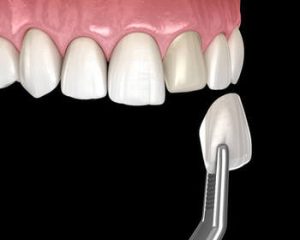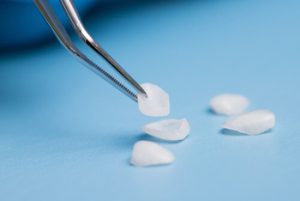Cosmetic dentistry offers myriad solutions for enhancing smiles, among which Lumineers and traditional veneers stand out. Lumineers and veneers are cosmetic dental treatments designed to address various dental imperfections, providing a more aesthetically pleasing appearance. However, there are critical distinctions between the two that potential patients should understand. This guide will look into the key differences, focusing on the advantages of traditional veneers over Lumineers while incorporating the necessary secondary keywords to compare thoroughly.
What Are Lumineers and Veneers?
Before discussing the differences, it’s essential to understand the differences between Lumineers and traditional veneers and how they function. Both options aim to refine the appearance of teeth, but their approaches and materials set them apart significantly. Additionally, both Lumineers and veneers effectively address cosmetic issues such as broken or chipped teeth.
Lumineers
Lumineers are a brand of dental veneers known for their ultra-thin design. They are typically about as thick as a contact lens and are made from a unique type of porcelain called Cerinate. Lumineers are designed to be applied with minimal to no tooth preparation, preserving the natural tooth structure underneath. When considering the cost of lumineers, choosing an experienced cosmetic dentist is important to avoid potential additional costs associated with improperly applied or low-quality Lumineers.
Traditional Porcelain Veneers
 On the other hand, traditional porcelain veneers are custom-made shells created to cover the front surface of the teeth. These veneers require some degree of tooth preparation, which involves removing a thin layer of tooth enamel to ensure a proper fit and natural appearance. Traditional veneers are known for their durability and ability to closely mimic the natural translucency of tooth enamel. Porcelain laminate veneers are also known for their stain resistance and high success rate in maintaining good condition over several years.
On the other hand, traditional porcelain veneers are custom-made shells created to cover the front surface of the teeth. These veneers require some degree of tooth preparation, which involves removing a thin layer of tooth enamel to ensure a proper fit and natural appearance. Traditional veneers are known for their durability and ability to closely mimic the natural translucency of tooth enamel. Porcelain laminate veneers are also known for their stain resistance and high success rate in maintaining good condition over several years.
Key Differences Between Lumineers and Veneers
Understanding the core differences between Lumineers and traditional veneers, two popular cosmetic dentistry treatments, can help you make an informed decision. These differences lie primarily in the preparation process, thickness, application, aesthetics, and durability.
Traditional veneers are often made from porcelain or composite resin, which impacts their appearance and durability.
Tooth Preparation
The preparation process is a significant factor that distinguishes Lumineers from traditional veneers.
- Lumineers: Minimal to no tooth preparation is required, which preserves more of the natural tooth structure.
- Traditional Veneers: Require removal of a thin layer of enamel, allowing for a better fit and more natural look.
Thickness
The veneers’ thickness can impact the dental work’s appearance and feel.
- Lumineers: Ultra-thin, often compared to the thickness of a contact lens.
- Traditional Veneers: Thicker than Lumineers, providing greater durability.
Application Process
The application process for Lumineers and traditional veneers differs in invasiveness and comfort.
- Lumineers: Generally less invasive, often not requiring local anaesthesia.
- Traditional Veneers: More invasive due to the enamel removal process, typically requiring local anaesthesia.
Aesthetics
Aesthetics are crucial when choosing veneers, as the goal is to achieve a natural-looking smile.
- Lumineers May appear bulkier due to their thickness and lack of enamel removal.
- Traditional Veneers Can provide a more natural appearance due to the tailored fit after enamel reduction.
Durability
Durability is another important consideration, particularly for those seeking long-term solutions.
- Lumineers: Less durable than traditional veneers, more prone to chipping over time.
- Traditional Veneers: Highly durable, lasting longer with proper care.
Why Traditional Veneers Lead the Way: The Ultimate Solution for More Dental Issues Than Lumineers
Traditional porcelain veneers offer several distinct advantages over Lumineers, particularly in aesthetics, durability, and customisation. Here’s a closer look at why traditional veneers might be the better choice for many patients. Temporary veneers cover the teeth while waiting for the custom veneers to be prepared and ready.
Enhanced Aesthetics
Traditional veneers are renowned for their ability to closely mimic the natural appearance of teeth. The necessity of enamel removal allows for a better fit, ensuring that the veneers align perfectly with the gum line and adjacent teeth. This results in a more seamless and natural-looking smile.
Durability and Longevity
Traditional porcelain veneers are highly durable, often lasting 10-15 years or longer with proper care. The strength of the porcelain used in traditional veneers makes them resistant to chipping and cracking, providing a long-term solution for various cosmetic dental issues.
Customisation
Traditional veneers are highly customisable. Dentists can tailor the veneers’ size, shape, and colour to match the patient’s natural teeth, ensuring a perfect match. This level of customisation is essential for achieving a natural and aesthetically pleasing result.
Better for Severe Dental Issues
Traditional veneers offer a more effective solution for patients with significant dental imperfections such as crooked teeth, severe discolouration, or substantial gaps. The preparation process allows dentists to address these issues more comprehensively, resulting in a more uniform and attractive smile. Traditional veneers are also effective for addressing chipped teeth, providing a comprehensive solution for dental imperfections.
Stain Resistance
Porcelain veneers are exceptionally resistant to staining, making them an excellent choice for individuals who want to maintain a bright, white smile without the need for frequent whitening treatments. While Lumineers are also stain-resistant, the superior durability of traditional veneers enhances their overall effectiveness in maintaining a pristine appearance.
Considerations for Choosing Traditional Veneers
While traditional porcelain veneers offer many benefits, some considerations should be made when deciding if they are the right choice for you.
 Tooth Preparation
Tooth Preparation
Some people view the requirement for tooth preparation in traditional veneers as a disadvantage. However, this process ensures a proper fit and natural look. The enamel removal is minimal and typically does not affect the tooth’s long-term health.
Permanent Solution
Traditional veneers are a permanent cosmetic procedure. Once the enamel is removed, it cannot be replaced. Therefore, patients must maintain their veneers and understand that future replacements may be necessary.
Cost
The cost of traditional porcelain veneers can be higher than that of Lumineers, primarily due to the additional preparation work and customisation. However, many patients find the investment worthwhile for the superior aesthetic and durable results.
The Role of a Cosmetic Dentist
Choosing between Lumineers and traditional veneers requires careful consideration and consultation with a qualified cosmetic dentist. An experienced cosmetic dentist can assess the patient’s dental health, discuss their aesthetic goals, and recommend the most suitable option. It’s essential to select a dentist with extensive experience in cosmetic dental procedures to ensure optimal results. A cosmetic dentist can help patients choose between veneers and Lumineers based on their dental needs and aesthetic goals.
FAQs on Lumineers vs Veneers
- Can Lumineers be removed if I change my mind?
Yes, Lumineers can be removed since they require minimal to no tooth preparation, leaving most of the natural tooth structure intact. However, once traditional veneers are placed, they are a permanent solution due to the enamel removal process.
- Do Lumineers or traditional veneers require special care?
Lumineers and traditional veneers require similar care to natural teeth, including regular brushing, flossing, and dental check-ups. Avoiding hard foods and using non-abrasive toothpaste can help prolong their lifespan.
- How do Lumineers and traditional veneers feel once applied?
Lumineers are ultra-thin and can sometimes feel slightly bulkier due to the lack of tooth preparation. With their customised fit and enamel removal, traditional veneers generally feel more natural in the mouth.
- Are there any specific dental issues that Lumineers cannot address?
Lumineers are less effective for severe dental issues like significant misalignment or large gaps between teeth. Due to their comprehensive preparation process, traditional veneers are typically recommended for more substantial cosmetic dental problems.
- What is the typical procedure time for getting Lumineers vs traditional veneers?
The process for Lumineers is usually quicker, often completed in two visits since minimal tooth preparation is involved. Traditional veneers may take longer due to the enamel removal and customisation stages, which usually require multiple visits.
- Are Lumineers suitable for everyone?
Lumineers may not be suitable for everyone, particularly those with severe dental issues or significantly discoloured teeth that the ultra-thin shells may not fully cover. A thorough dental examination by a cosmetic dentist can determine suitability.
- Do Lumineers or traditional veneers require more maintenance?
Lumineers and traditional veneers require consistent dental hygiene practices to maintain their appearance and longevity. Regular dental visits are essential to check their condition, but neither option demands more maintenance. Proper care ensures both types of veneers stay in good condition.
- What are the main differences between veneers and Lumineers?
When evaluating veneers vs Lumineers, the main differences lie in their materials and application process. Traditional veneers are typically made of porcelain and require enamel removal, making them a permanent solution. Lumineers, conversely, are ultra-thin and made from a special type of porcelain that requires minimal to no tooth preparation. Key factors to consider include the condition of your teeth, desired results, and the procedure’s invasiveness.
The Superior Choice for a Lasting Smile
 In the debate of Lumineers vs veneers, traditional porcelain veneers offer several distinct advantages, particularly in aesthetics, durability, and customisation. While Lumineers provide a less invasive option with minimal tooth preparation, they may not always achieve the same natural look and long-term results as traditional veneers.
In the debate of Lumineers vs veneers, traditional porcelain veneers offer several distinct advantages, particularly in aesthetics, durability, and customisation. While Lumineers provide a less invasive option with minimal tooth preparation, they may not always achieve the same natural look and long-term results as traditional veneers.
Traditional porcelain veneers often emerge as the superior choice for individuals seeking a thorough and lasting solution to dental imperfections such as stained teeth, crooked teeth, or gaps. However, the decision should always be made in consultation with a skilled cosmetic dentist who can guide the patient through the process, ensuring the best possible outcome for their unique needs.
For more information or to schedule a consultation, contact Beyond Infinity Dental at (02) 8806 3799. Our experienced team is here to help you achieve the smile of your dreams.
References:
Colgate. (n.d.). Dental veneers: Pros and cons. Colgate Oral Care Center. Retrieved from https://www.colgate.com/en-us/oral-health/veneers/dental-veneers-pros-and-cons
Myzerodonto. (n.d.). The study of the structure of natural teeth is the foundation of a biomimetic approach to restorative dentistry: A healthy tooth does not have cracks into dentin. If a crack into dentin occurs, symptoms often develop. Myzerodonto. Retrieved from https://www.myzerodonto.com/the-study-of-the-structure-of-natural-teeth-is-the-foundation-of-a-biomimetic-approach-to-restorative-dentistry-a-healthy-tooth-does-not-have-cracks-into-dentin-if-a-crack-into-dentin-occurs-sympto/
Fisher, D. (2023, May 24). Different types of cosmetic dental procedures. Verywell Health. Retrieved from https://www.verywellhealth.com/different-types-of-cosmetic-dental-procedures-1059022
National Health Service. (n.d.). Teeth whitening. NHS. Retrieved from https://www.nhs.uk/conditions/teeth-whitening/









